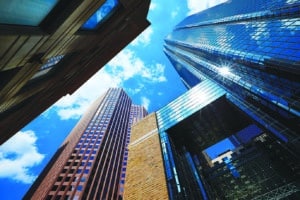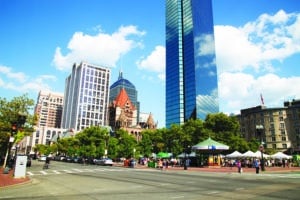The Back Bay stands atop Boston’s booming office market once again.
Corporate suites in Back Bay’s best high-rises fetch more than $72 per square foot, compared to $65.90 in the Financial District and $63 in the Seaport, according to Jones Lang LaSalle.
Nor is Back Bay’s perch atop the city’s office market likely to be seriously challenged anytime soon, despite all the hype about the up-and-coming Seaport and Millennium Partners’ plan for a new Financial District skyscraper.
The numbers reflect a simple truth: Back Bay remains the most coveted corporate address in the city.
But to understand why the Back Bay is such a highly desirable location for businesses of all stripes, you need to look beyond neighborhood’s high-profile towers, as impressive as they may be.
“The Back Bay … has a desirable live/work/play environment and is this market’s original ‘18-hour’ district,” said Brendan Carroll, director of intelligence at Perry Brokerage Assoc. in Boston. “I think the overall value proposition, limited inventory and historically low vacancy rates has created the premium.”
No Sterile Corporate Village
Compared to the city’s other commercial centers, Back Bay still holds a very big lead when it comes to the quality of life the neighborhood offers for businesses and their employees, whether they are there just during the daylight hours or live in the neighborhood as well.
The city’s most prominent retail venues – barring Faneuil Hall – can all be found in the Back Bay.
It’s an embarrassment of riches, with the neighborhood boasting both indoor, upscale malls like Copley Place and the Prudential Mall and outdoor venues like Newbury and Boylston streets.
There are dozens of restaurants – the Back Bay Association lists 45 just under the category of “fine dining” – and thousands of hotel rooms.
Together, these help the neighborhood truly feel like a neighborhood, as opposed to the Seaport’s gawky, glass-and-steel high-rises emerging from a warren of surface parking lots.
The Back Bay is a successful blend of old and new, with older brownstones lining 19th century residential boulevards like Commonwealth, Marlborough and Dartmouth avenues, even as new towers like Clarendon, Trinity Place and the Mandarin Oriental have taken shape near Copley Square, the Prudential Center and the neighborhood’s commercial hub.
Knitting it altogether are cultural crown jewels like Copley Square, the Boston Public Library and Trinity Church.

Skyscrapers soar up from Congress Street in Boston’s Financial District.
Envious Competitors
Imitation says it all. The developers and real estate investors who own towers in the Financial District and the Seaport – not to mention the planners over at City Hall – would just love to steal a page from Back Bay’s playbook.
They want not just the high rents that Back Bay commands, but the restaurants, shops and residences that make the neighborhood a destination, as opposed to a commuting hub.
But getting there won’t be easy.
To that end, Millennium Partners broke ground last fall on its $1.3 billion complex, slated to go up on the site of the Financial District’s old Winthrop Square parking garage.
Its two towers connected by glass walkways – one 690 feet tall, the other 579 feet tall – rise atop a 65-foot Great Hall. Set to open in 2022, it will feature not just 750,000 square feet of office space but, in a still unusual move for the Financial District, 500 residential units as well.
Yet the final design of the tower – it went through three different iterations out of concerns it would cast shadows on Boston Common – doesn’t look all that much different from what’s there right now in the Financial District.
It fits in just fine with the impersonal, homogenous corporate obelisks that make the Financial District interchangeable with 1970s- and ’80s-era downtowns in any number of American cities.
The only bright splash of life in the deadly dull district is the Post Office Square park, but the postage-stamp-sized oasis is too small to change the area’s essential character (or lack of it).
And while Millennium has done very well selling multimillion-dollar condos to the rich in towers that, if not cookie-cutter projects, are hardly architectural statements, the jury is out on its ability to pull up the surrounding neighborhood.
It took years for the porn shops and other vestiges of the old Combat Zone to finally give up the ghost after Millennium built the Ritz-Carlton towers down on once-seedy lower Washington Street. The high-rises were a world unto themselves, with the condo owners insulated from their surroundings.
As for the Seaport, there’s certainly the promise of something better and more well-rounded taking shape there.

Scott Van Voorhis
There’s a far greater proportion of condominiums and apartments in the Seaport, for starters. The renovated Victorian warehouses in adjacent Fort Point have attracted top culinary entrepreneurs while also providing a nice contrast to the shiny, raw-boned towers jutting up along the waterfront.
Still, there are some structural issues that will hinder the Seaport’s development into something more pleasant, if not charming. Given the district’s main arteries like Seaport Boulevard were built wide to funnel traffic on and off the Massachusetts Turnpike, it’s hard to see the area ever achieving the pedestrian-friendly ambiance that marks the Back Bay.
Maybe someday office towers in the Seaport and the Financial District will finally boast the top rents in the city.
But right now that someday is a long way off, and it won’t happen until the Seaport and the Financial District find a way to develop some of the neighborhood charm that has made the Back Bay such a draw.
Scott Van Voorhis is Banker & Tradesman’s columnist; opinions expressed are his own. He may be reached at sbvanvoorhis@hotmail.com.




 |
| 
